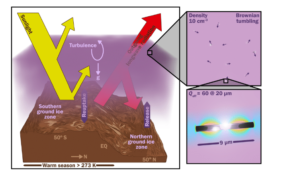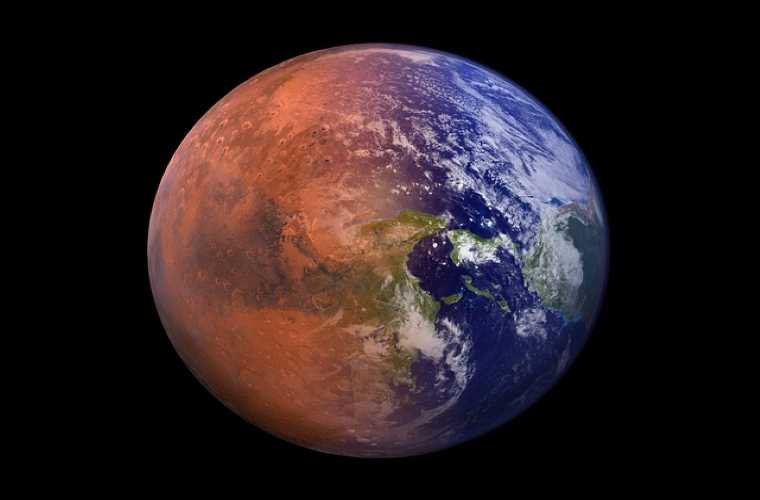Researchers studying concepts for terraforming Mars to make it habitable for possible human colonization have found that using metal nanorods injected into the planet’s atmosphere could accomplish the task 5,000 times faster than popular approaches involving the release of greenhouse gasses.
The authors of the study published in the journal Science Advances also determined that the massive number of metal nanorods needed to accomplish the planetary engineering task could be manufactured from iron and aluminum available on Mars.
“We show here that artificial aerosols made from materials that are readily available at Mars—for example, conductive nanorods that are ~9 micrometers long—could warm Mars >5 × 103 times more effectively than the best gases,” they write.
Terraforming Mars: from Science Fiction to Science Fact
Terraforming Mars or any other planet to make it habitable for humans is a staple of science fiction. While some of those stories take place in galaxies far, far away, one of the most common targets for this fictional planet-wide engineering is Earth’s next-door neighbor, Mars. This is most likely due to the similarities the two worlds share, including residing in our star’s habitable zone, where water could, in theory, exist on the planet’s surface.
As the press release announcing the new research points out, “many of these strategies involve greenhouse gas-based warming, but the planet is sparse in ingredients necessary for greenhouse gas production.” Such a method would also likely take thousands of years to accomplish, which would require hundreds of generations of humans to continue the effort.
Curious if there was a better approach to terraforming Mars, researchers Samaneh Ansari and Hooman Mohseni from Northwestern University teamed up with Ramses Ramirez from the University of Central Florida, Liam Steele from the European Center for Medium-Range Weather Forecasts, and Edwin Kite from The University of Chicago. Together, the research team evaluated a number of potentially technologically viable scenarios before ultimately landing on the idea of atmospheric metal nanorods.
Nanorods Similar in Size to Martian Dust Particles Trap Heat to Melt Subsurface Water
After settling on the idea of atmospheric insertion of metal nanorods, the team used a version of the MarsWRF global climate model along with another supplemental 1-D model. According to the team’s study, their computer simulations showed that a sufficient number of metal nanorods scattered in the atmospheres “would amplify sunlight that reaches the Martian surface and block ground heat from escaping.”
“Such nanoparticles forward-scatter sunlight and efficiently block upwelling thermal infrared,” they write. “Like the natural dust of Mars, they are swept high into Mars’ atmosphere, allowing delivery from the near-surface.”
The team notes that their proposed nanorods would be similar in size to natural Martian dust, “essentially, a little smaller than glitter,” and should be able to soar high into the atmosphere after being dispersed.
Meanwhile, “the rods’ other properties should help them settle 10 times slower than natural dust,” they explain.


According to the team’s computer models, their manufactured metal nanorods could stay aloft for as much as 10 years. If accurate, this long lifetime combined with enough nanorods delivered over a protracted period of time could immediately start the most critical element to terraforming Mars: melting the planet’s ice.
“For a 10-year particle lifetime, two climate models indicate that sustained release at 30 liters per second would globally warm Mars by ≳30 kelvin and start to melt the ice,” the researchers write.
This melting ice would not only make water available for future living organisms but, according to the authors, essentially start a chain reaction toward a more habitable Mars.
“After a few months, atmospheric pressure would then increase by 20%, creating the conditions to begin a feedforward loop involving the volatilization of carbon dioxide,” they write.
Study Suggests Barrier to Terraforming Mars May Be ‘Less High’ Than Previously Thought
While the team’s models show their method might be 5,000 times more effective than greenhouse gas strategies, they caution that the process would still take centuries to work. They also note that even after the planet is sufficiently warm, more work would need to be done to make it truly habitable.
“Raising Mars’ temperature, by itself, is not sufficient to make the planet’s surface habitable for oxygenic photosynthetic life,” the authors caution. “On the other hand, if a photosynthetic biosphere can be established on the surface of Mars, perhaps with the aid of synthetic biology, that might increase the Solar System’s capacity for human flourishing.”
Ultimately, the research team says their models showed significant promise, offering researchers who study planet formation and planet terraforming strategies a faster and more feasible approach than popular greenhouse gas proposals.
“If nanoparticles can be made at scale on (or delivered to) Mars, then the barrier to the warming of Mars appears to be less high than previously thought.”
Christopher Plain is a Science Fiction and Fantasy novelist and Head Science Writer at The Debrief. Follow and connect with him on X, learn about his books at plainfiction.com, or email him directly at christopher@thedebrief.org.

